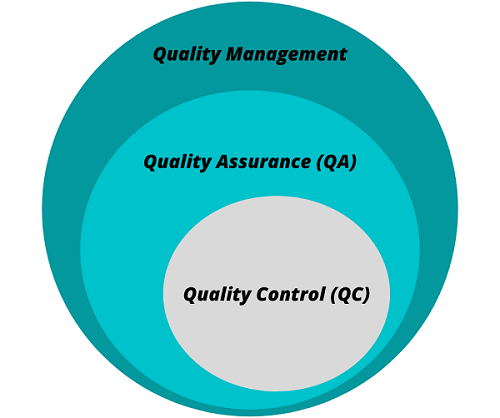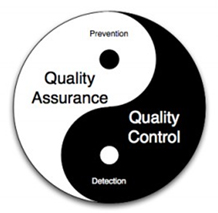In a life sciences industry rife with similar sounding terminologies however. Proactive response care makes sure that patients receive highest care possible.

Quality Assurance Vs Quality Control Decode
On the contrary in quality control quality is created at the control stage.

. Quality ControlQC tests the end product to discover and root out defects. Quality Assurance is a preventive action but Quality Control is a corrective measure. Risk management then is a financial function.
Deployment of healthcare risk management has traditionally focused on the important role of patient safety and the reduction of medical errors that jeopardize an organizations ability to achieve its mission and protect against financial liability. There is little to be gained by thinking of them as separate entities and much to be gained by sharing the lessons of both. Quality assurance QA quality control and the overarching quality management system are the core elements of production consistency.
Quality System Quality Assurance and Quality Control Relationships. Sure compliance and risk management are different. By its nature risk management primarily focuses on reducing financial loss.
Quality Assurance is a staff function which is not in the case of Quality Control. The interface between a proactive risk management program and a quality assurance program is dynamic and can serve the legitimate interests of both. Using the simplified definition of Risk Management above it is primarily.
The truth is that like quality management risk management is a career-path. If one thinks of risk management in terms of risk to quality patient care and that assuring quality is the. The focus of quality improvement is to improve processes and outcomes of patient care.
This can be achieved through examining and managing risks to the. Quality improvement focuses on achieving best possible outcomes. Threats to patient safety are a key element of a broad array of risks that healthcare organizations need to consider.
Quality AssuranceQA focuses on fine-tuning the processes necessary to avoid defects in the end product. Systems Integration In the field of management systems there exists the belief that many organizations having multiple. Automating and streamlining administrative tasks while serving as a crucial analytics tool.
Establish the quality management system and procedures. Iv risk characterization However this is actually part of a risk analysis with risk analysis defined as A process consisting of three components. Through risk management you reduce customer risk while ensuring the quality of your product.
But different permutations of these traditional labelstitles are arising. Ultimately the right risk management technology can serve the dual purposes of compliance and risk management programs because of its own dual purpose. Quality control is a part of quality management focused on.
Reducing clinical error is a welcome byproduct of risk management activities but not the primary motivation. As stated in NIST 800-30 the risk assessment process is a key component of the risk management process. Higher-quality risk assurance to key stakeholders with reporting thats organized by consolidated risk themes sharing risk management and assurance methods within the organization and monitoring the methodology and its results as the adoption of the integrated risk model evolves.
So if QC finds defects QA may go back and reevaluate processes to eliminate those end errors. Suddenly every ISO 9001 and quality consultant is claiming instant overnight expertise in risk management. May 7 2021 By Gina Guido-Redden Co-Founder and COO Coda Corp USA.
In quality assurance quality is created during the designing phase. Plan and conduct internal quality audits. With the inclusion of risk-based thinking in ISO 90012015 never before has the quality management profession spent so much time talking about risk management.
HRSA is committed to a comprehensive approach to quality improvementquality assurance that includes risk management. To support health centers and free clinics HRSA provides FREE access to the ECRI Institute Clinical Risk Management Program. It aims to prevent defects before they occur through process design.
Both risk management and quality management strategies must find ways to take account of uncertainty. Risk management policies are an integral part of a wide scale quality improvement program. QC is reactive and exists to identify defects in the quality of products after they have happened.
Defining designing assessing monitoring and improving the quality of healthcare. Ensure that the quality control procedures are implemented during every step of the production process. Overview of Issue Risk managers leverage the links between risk management patient safety and quality improvement.
But with the expanding role of. Risk management risk assessment and risk communication1 So do we have four things to do as part of our risk assessment and is that part of a bigger thing called a risk analysis. Traditional labels are still widely accepted such as risk management quality management and patient safety etc.
According to the Open Group risk assessment includes processes and technologies that identify evaluate and report on risk-related concerns. Risk management is implicit in the daily tasks of a successful professional in quality management. Quality assurance can be defined as part of quality management focused on providing confidence that quality requirements will be fulfilled The confidence provided by quality assurance is twofoldinternally to management and externally to customers.
Nobody wants to handle a crisis which is why quality professionals are choosing to be proactive about managing risk. Probability or predictability that something will happen usually negative Risk Managment Definition. Quality Assurance QA and Quality Control QC are the two aspects of quality management.
Theyre also a manufacturers fundamental mechanisms for maintaining regulatory compliance and making continual improvements. Reactive QC Effective quality assurance is proactive. A Primer for Lean Quality Assurance.
The Value and Purpose of Risk Management in Healthcare Organizations. Newer labels are being used to describe the various quality management risk management and patient safety operations within healthcare organizations. They both look similar but there are some distinct differences between the two concepts.
Work with a third party to certify the organization to ISO 9001 or other applicable standards. A Document Management System is Key to the Quality Management Process.

Quality Assurance Vs Quality Control System Procedures Safetyculture

Quality Assurance Vs Quality Control What S The Difference Mead Hunt

The Difference Between Quality Assurance And Quality Control Open Dialog Dialog Information Technology
0 Comments